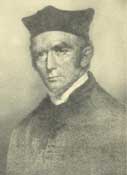David Einhorn
(1809-1879)

David Einhorn was born in Bavaria in 1809. He studied rabbinics and philosophy. He was one of the early Reformers and was greatly influenced by both Abraham Geiger and Samuel Holdheim. In 1842, he supported Geiger and publicly stated that there the Talmud had no divine authority. At the Frankfort Rabbinical Conference in 1845, he enthusiastically pushed for having the service in the vernacular and for cutting out all references to the restoration of the sacrifices and a Jewish state.
Einhorn’s positions were considered so radical that even though congregations selected him to serve as their rabbi, the Bavarian government refused to confirm his appointments.
In 1847, Einhorn succeeded Samuel Holdheim as chief rabbi of Mecklenburg-Schwerin. He got involved in a series of controversies, realized he had little future as a rabbi in Europe, and headed for the country of liberal opportunity, America.
His arrival in the United States coincided with the Cleveland Rabbinical Conference, which, under the leadership of Isaac Mayer Wise, adopted a platform designed to permit a broadly based union among the various tendencies in American Judaism. Einhorn regarded this platform as treachery to the cause of Reform and denounced it violently. This marked the beginning of a bitter feud between Einhorn, the uncompromising Reformer, and Rabbi Isaac Mayer Wise, who was ready to moderate his Reform in the interests of unity. Einhorn became rabbi at Har Sinai Congregation of Baltimore in 1855. He wrote a new Reform Jewish prayer book with the majority of the text in German called Olat Tamid. Unlike Minchag America (Isaac Mayer Wise’s prayer book), Olat Tamid not only shortened the traditional service; it was a creative work expressing Einhorn’s Reform ideal of the universality of humanity with an anti-particularistic strain. In its modern approach to worship, it cut out Kol Nidrei; it utilized various Sephardic piyyutim (religious poems); it dropped the Musaf service entirely; it did not include blessings for the blowing of shofar or the lighting of Chanukah lights; it de-emphasized Israel as the Chosen People; and it removed all references to a personal Messiah, a return to Israel, or the resumption of the sacrificial cult.
Einhorn’s rabbinate in Baltimore, Maryland, a pro-slavery state, was cut short in 1861 when his outraged denunciation of slavery placed him in danger. A mob threatened to tar and feather him, and he had to flee north. He became rabbi of Congregation Kenesseth Israel in Philadelphia. In 1866 he moved to New York, where he became rabbi of Congregation Adath Israel.
In 1869, he attended the Philadelphia Rabbinical Conference. A powerful and fiery speaker, he influenced that group to adopt a radical, Reform platform, alienating the more traditional American Jewish groups.
Although Isaac Mayer Wise’s more moderate positions eventually became the norm for American Reform Jewish institutions, Einhorn's more radical view of Reform Judaism greatly influenced Kaufman Kohler, his son-in-law and disciple. Kohler formulated the Pittsburgh Platform of 1885, which became the basis for American Reform. Kohler was also instrumental in writing The Union Prayer Book, which he based on Einhorn’s Olat Tamid.
Sources: Gates of Jewish Heritage. Photo from “Sinai,” Vol. VI, Translated from the German, p. 2-22, Baltimore, 1861, by Mrs. Kaufmann Kohler.


